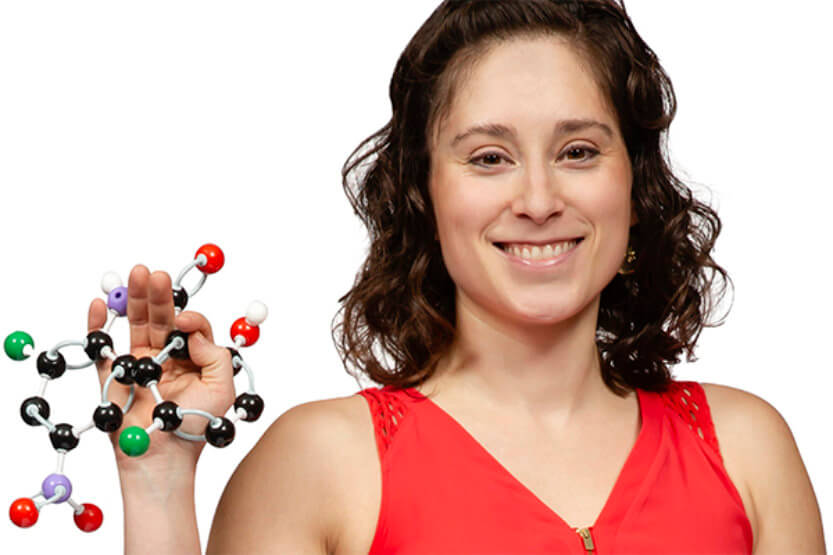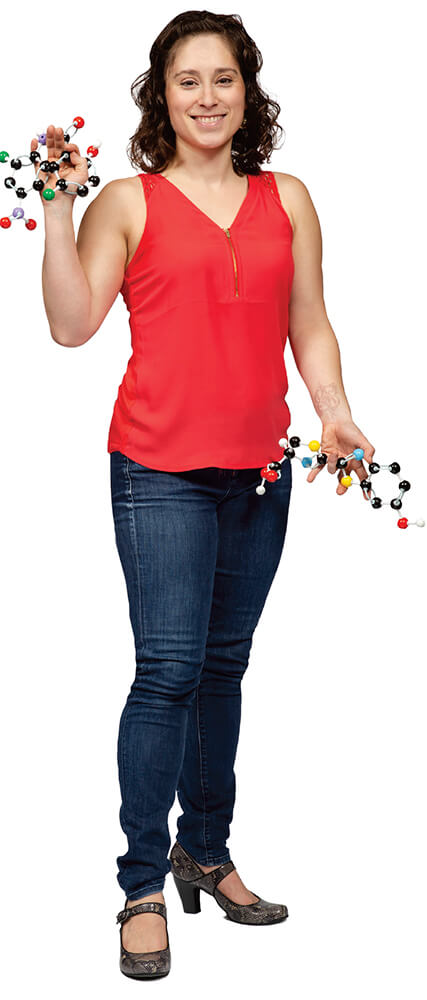In Class: Mixologist
 Organic chemistry lecturer Jordan Axelson (Image by L. Brian Stauffer)
Organic chemistry lecturer Jordan Axelson (Image by L. Brian Stauffer) Chemistry 232 has a reputation because a lot of pre-med students have to take it as a required class. On the first day, I am honest with them that organic chemistry takes a lot of work, a lot of practice and a lot of time. There’s a great deal of content, and we do move fast.
I also tell my students that general chemistry—the first chemistry class I took when I was an undergraduate here at Illinois—was really hard for me. I was crying after my first exam. I called my parents and told them that I was convinced I had failed it. And they told me that I couldn’t come home. I decided that I was going to have to work hard. So I did all the practice problems, did all the reading, went to all of my TA’s office hours and got as much help as I could. And things got better. But I had to work really, really hard.
The beautiful—and dangerous—thing about organic chemistry is that it builds on itself. The concepts and the information that we learn at the beginning of the semester are woven through the whole fabric of this class. I tell my students, “You’re going to see this over and over again. You’re going to use this over and over again. If you get this, then it’s a tool that you can use the rest of the semester. But if you don’t fully understand it, or there’s a piece missing, that could potentially hurt you all the way through the semester.”
Sometimes I feel like chemistry gets a bad rap. You say the word “chemical” and people automatically assume that’s bad. But everything’s a chemical. Our bodies are made of chemicals. Chemicals are not inherently bad things, dangerous things. And then there’s the stigma of chemistry being very hard. It is very hard. But it also can be beautiful and exciting and fun.
Our department’s annual holiday demo show does a great job of showcasing those aspects of chemistry. There are explosions. Things are lit on fire. Color-change magic tricks. We always ask the audience: “Is it science or is it magic?” Most of the kids who come catch on pretty quickly that the answer is supposed to be “science.”
I do a trick where someone chooses a card and I magically reveal it. I don’t want to go into too much detail about this trick—that’s why it’s magic. There’s another trick where someone takes a pickle and lights it up like a lightbulb. I’ve only gotten to do that once.
I do have a little bit of a beef with the chemistry demo show. Blowing things up, lighting things on fire—it’s a spectacle, and it’s wonderful. And as an undergraduate, you see that and you say, “Oh, I want to do that as my job.” And then you actually get into chemistry, and they tell you that your goal is not to blow anything up. That lighting things on fire is bad. And I want to say that’s a little bit of a bait-and-switch. Just a little bit. Okay, so I just got that off my chest.
Edited and condensed from an interview conducted on Sept. 11, 2019.
Editor’s Note: “Holiday Magic” chemistry demonstration shows will be held this year at 7 p.m. on Dec. 11, and at 2 p.m. on Dec. 14 and 15. Free and open to the public, the demonstrations take place at 100 Noyes Lab.


